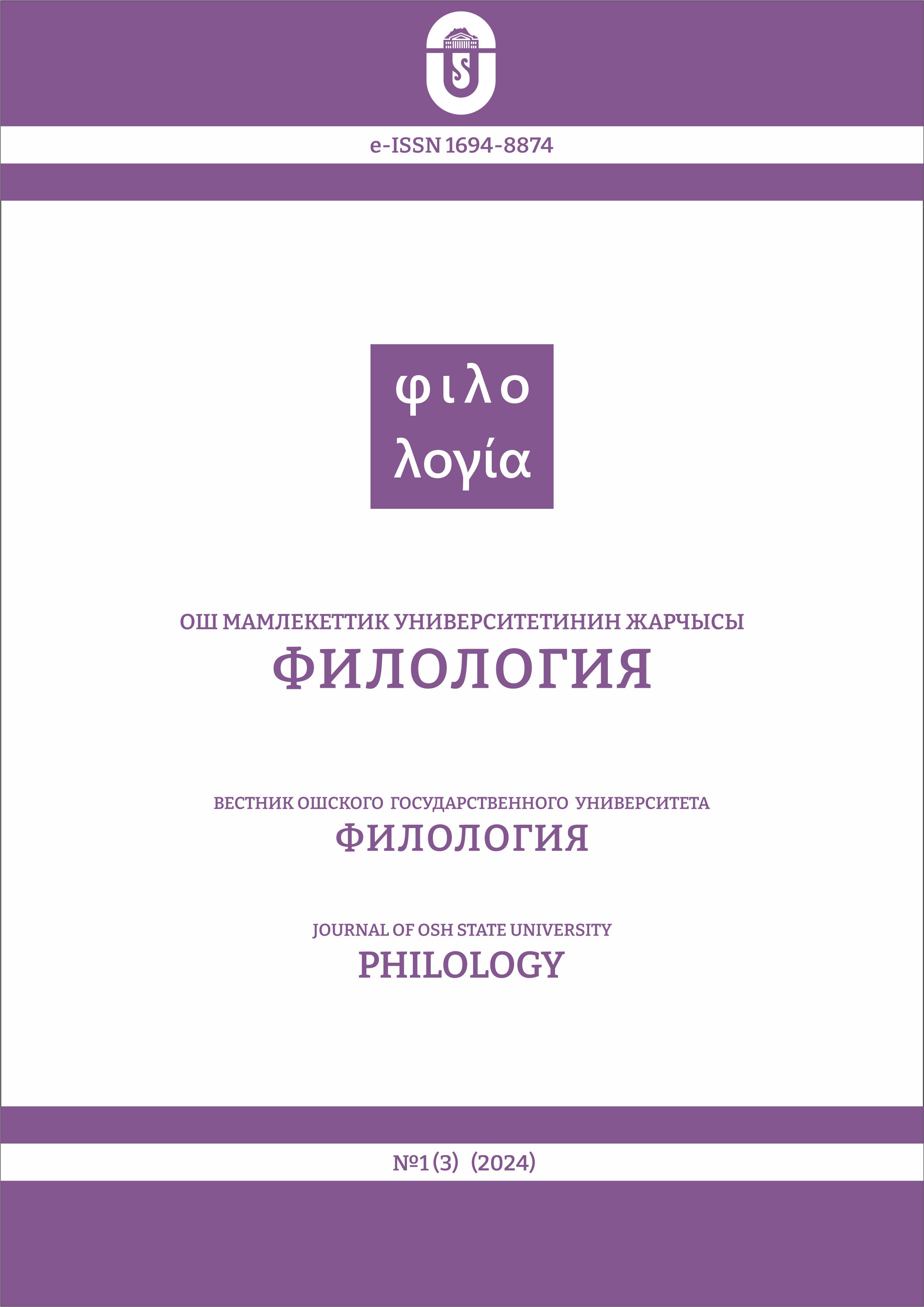“COMMON TENSE” IN THE KYRGYZ LANGUAGE
DOI:
https://doi.org/10.52754/16948874_2024_1(3)_3Keywords:
tense category, jalpy chak, geniş zaman, Old Turkic, old Uyghur eraAbstract
Категория времени является основным признаком глагола, и именно она отличает его от других частей речи. Глаголы передают действия или состояния бытия в различных временных рамках: они обозначают события, произошедшие в далеком или недавнем прошлом, действия, которые повторяются или продолжаются в настоящем, и ожидания будущих событий, а также многие другие временные нюансы. В частности, известно, что Present Simple в английском языке и Geniş Zaman в турецком языке представляют собой тип времени, который не ограничивается ни одним из трех времен и используется для выражения постоянных, повторяющихся действий. Такое временное значение рассматривается в грамматике кыргызского языка в рамках типа времени, называемого простым настоящим временем или настоящим-будущим временем. Однако, есть случаи, когда это время также выражает прошедшие действия. Таким образом, необходимо проанализировать его с новой точки зрения, принимая во внимание более широкие функциональные роли рассматриваемого времени. В этой статье рассматривается конкретное время, общее время (жалпы чак), исследуется его роль во временных рамках языка, его терминология, его положение как в исторических, так и в современных тюркских языках, а также его организационная парадигма.
References
Абдувалиев, И., Садыков Т. (1997). Азыркы кыргыз тили. Морфология. Бишкек: Айбек.
Абдулдаев, Э., Давлетов, С., Иманов, А., Турсунов, А. (1986). Кыргыз тили. Фрунзе: Мектеп.
Баскаков, Н.А. (ред.) (1975). Грамматика хакасского языка. Москва: “Наука”.
Грамматика азербайджанского языка (фонетика, морфология и синтаксис). (1971). Под. общ.ред. М.Ш. Ширалиева, Э.В. Севортяна. Баку: “ЭЛМ”.
Куликовская, Л.К. Мусаева, Э.Н. (2006). Грамматика казахского языка в таблицах и схемах в сопоставлении с грамматикой русского языка (простое предложение). – Алматы.
Кыргыз тилинин жазуу эрежелери: Соңку редакциясы. (2016). Кырг. Респ. Президентине караштуу Мамл. Тил б-ча улут. Комис. 3-бас. Бишкек.
Кыргыз тилинин сөздүгү. (2010). Бишкек: “Avrasya Jayıncılık”.
Покровская, Л.А. (1964). Грамматика гагаузского языка: фонетика и морфология. Москва: “Наука”.
Cагынбаева, Б., Дербишева, З. (2014). Түрк жана кыргыз тилдеринин салыштырма морфологиясы / Türkçe-Kırgızca Karşılaştırmalı Morfoloji. Кыргыз-Түрк “Манас” университетинин басылмалары: 146. Бишкек.
Серебренников, Б.А., Гаджиева, Н.З. (1986). Сравнительно-историческая грамматика тюркских языков. Москва: Наука.
Татар грамматикасы: өч томда. Т. II. (2016). Хисамова, Ф.М. (ред.) проект җит. М.З. Зәкиев. – Тулыландырылган 2 нче басма. – Казан: ТӘһСИ.
Харитонов, Л.Н. (1947). Современный якутский язык. Часть первая: фонетика и морфология. Якутск: ГОСИЗДАТ ЯАССР.
Ысқақов, А.Ы. (1991). Қазіргі қазақ тілі: Морфология. Алматы: Ана тілі.
Çelik, G. (2021). Közdüü monçok cerde kalbayt. Ala-Too curnalı. Bişkek: “Turar” basması.
Durmuş, O. (2009). Çuvaşçanın Şekil Bilgisi (Yayınlanmamış Doktora Tezi). Edirne: Trakya Üniv. SBE, Türk Dili ve Ed. ABD, Türk Dili BD.
Ercilasun, A.B. (2006). Karşılaştırmalı Türk Lehçeleri Grameri I. Fiil Basit Çekim. Ankara: TDK.
Ercilasun, A.B. (2010). Başlangıcından Yirminci Yüzyıla Türk Dili Tarihi. Ankara: Akçağ Yayınları.
Erdem, İ. (2007). “Mikyâsu’l-Lisân Kıstâsu’l-Beyân’daki Dil Bilgisi Terimleri”. Journal of Turkish Studies 2(2). бб. 192-216.
Ergin, M. (2009). Türk Dil Bilgisi. İstanbul: Bayrak Yay.
İdben, E. İ. (2010). “Muhtasar Sarf-ı Osmani Ali Nazima”. Türk Dili Araştırmaları Yıllığı - Belleten, 55(2007/2), бб. 67-88.
Karaağaç, G. (2009). Türkçenin söz dizimi (2. Baskı). İstanbul: Kesit Yayınları.
Kirişçioğlu, M.F. (2007). “Saha Türkçesi (Yakutça)”. Türk Lehçeleri Grameri. Ed. Ercilasun, Ahmet B. Ankara: Akçağ Yay.
Korkmaz, Z. (2014). Türkiye Türkçesi Grameri. Ankara: TDK. Yay.
Korkmaz, Z. (2009). Türkiye Türkçesi Grameri Şekil Bilgisi. Ankara: TDK. Yay.
Yazım Kılavuzu. (2009). Haz. Şükrü Halǔk Akakin. Ankara: Türk Dil Kurumu Yayınları.

